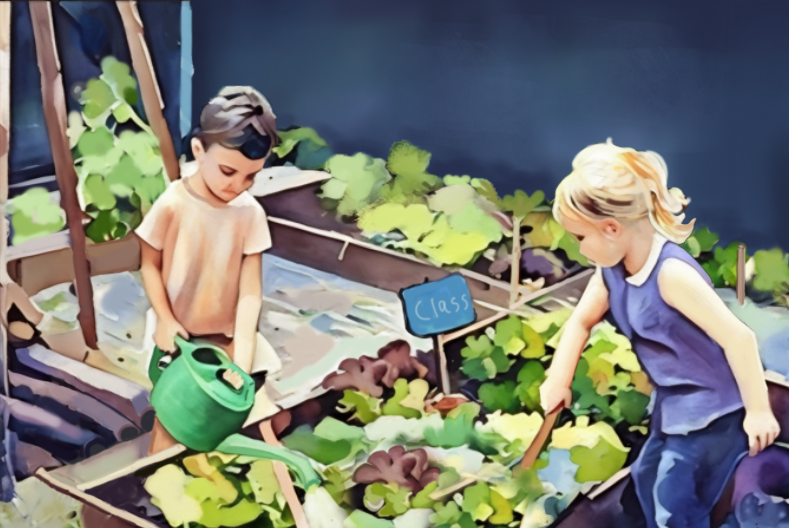
A young child can sit on the floor and enjoy a toy that beeps and shakes, but give them a beach, and the world is their oyster. When we immerse children in the most basic principles of our natural world, such as sand and water, the possibilities for imaginative play and breakthrough learning are endless. According to the National Association for the Education of Young Children (NAEYC), children “do not require more toys when they have the experience of using their own ideas and imagination in an open space, with basic materials waiting to be transformed.” (Lanser, 1991, 9) At a time when some people are simply giving up on a brighter and healthier future for our earth, it is more important than ever that we instill a value of environmentalism in our children, allowing them to connect with nature. Not only does outdoor learning help children develop fun memories that make them value our earth, but it is also of the greatest benefit to their young growing minds in more ways than one.
Children learn by observing the physical properties of sand, dirt, or water, staring at the sky, watching as bugs crawl, or even laughing at their shadows as they begin to understand the sun. Adults often view spending time outside as a passive experience, but stargazing, or “astronomical science, for example, has many observable events and aspects that may appeal to young children’s interests” (Counsell, 2023, p.14) and teaches them about complex phenomena. The outdoors is both a playground and a classroom. Beyond basic learning, some groups, such as the Māori, even believe that within outdoor education, there are “spiritual benefits that may take place when nature-human interactions are not mediated by and/or through a screen” (Reed, 2024, p.3)
As a leader in early childhood outdoor education, the Scandinavian Early Childhood Education and Care industry identifies “Outdoor Pedagogy” as one of its four crucial pillars. This manifests in their goal “to promote the joy of discovery, identity formation, and the development of physical and mental agility in all children” (Carlbaum, 2024, p.23). This means their preschools have spacious gardens that encourage physical activity such as “climbing, crawling, and pulling up” (Carlbaum, 2024, p.24) to emphasize the physical well-being of the child as well. As a child in this system, you “are outdoors a lot… you grow plants, you do a whole lot of excursions” (Carlbaum 2024, p23). Although less common, there are preschools in the U.S. emphasizing access to the outdoors, such as Stanford’s Bing Nursery School, which advertises “classrooms that open wide to a sprawling terrain of hills, rabbit hutches, fruit trees, and play structures” (“Program Overview”).
Going back to the endless possibilities of a beach, those material interactions can be created in an outdoor preschool area with a simple sand pit and water. In a sandpit, children can “develop hand-eye coordination while manipulating and organizing props, sand, and water” (Perry, 2001, p.6). They can observe the ways the materials interact with each other and the shift in physical properties between dry and wet sand. As they scoop and pour, children may also begin to use their imagination to make sense of their sensory learning experiences. Given that “with less explicit cues than those inside the classroom, outdoor play challenges children’s abilities to interpret” (Perry, 2001, p.5), it can be assured that this type of play can challenge young children to grow socially, linguistically, and cognitively. Furthermore, as children“invent and develop games, they interact with playmates to arrive at consensual rules about how the game is to be played” (Perry, 2001, p.6), which enhances their ability to learn compromise and listening skills to play cohesively with their friends.
As demonstrated by intensive observational research, emphasizing outdoor education in early childhood and beyond will not only benefit the up-and-coming generations of the present but will also scaffold their appreciation for our natural world. When people have experienced first-hand the positive impact the outdoors provides our lives socially, emotionally, and educationally, it will foster a global community that desires to protect it. After all, nature is our children’s most crucial cradle.
Works Cited
Carlbaum, S., & Rönnberg, L. (2024). “We help Germany create greater equality.” Logics and rationales in exporting ‘Scandinavian’ early childhood education and care. Education Inquiry, 15(1), 11-29. https://doi.org/10.1080/20004508.2023.2271685
Counsell, Shelly L. “Looking Toward the Skies.” Science and Children, vol. 60, no. 7, 2023, pp. 14. ProQuest, https://www.proquest.com/scholarly-journals/looking-toward-skies/docview/2890075305/se-2.
Lanser, Shirley, and Laura McDonnell. “Creating Quality Curriculum Yet Not Buying Out the Store.” Young Children, vol. 47, no. 1, 1991, pp. 4–9. JSTOR, http://www.jstor.org/stable/42725242. Accessed 9 Oct. 2024.
Perry, Jane. Outdoor Play: Teaching Strategies with Young Children. Teachers College Press, 2001.
“Program Overview.” Bing Nursery School, Stanford School of Humanities & Sciences, bingschool.stanford.edu/childrens-programs/program-overview. Accessed 9 Oct. 2024.
Reed, Jack, et al. “Journal of Adventure Education and outdoor learning: Special issue: Digital Technology and networked spaces in outdoor learning.” Journal of Adventure Education and Outdoor Learning, vol. 24, no. 1, 2 Jan. 2024, pp. 1–6, https://doi.org/10.1080/14729679.2024.2316444.
Tonge, K. L., Jones, R. A., & Okely, A. D. (2019). Quality Interactions in Early Childhood Education and Care Center Outdoor Environments. Early Childhood Education Journal, 47(1), 31-41. https://doi.org/10.1007/s10643-018-0913-y
The views and opinions expressed are those of the authors and do not necessarily reflect nor represent the Earth Chronicles and its editorial board.




